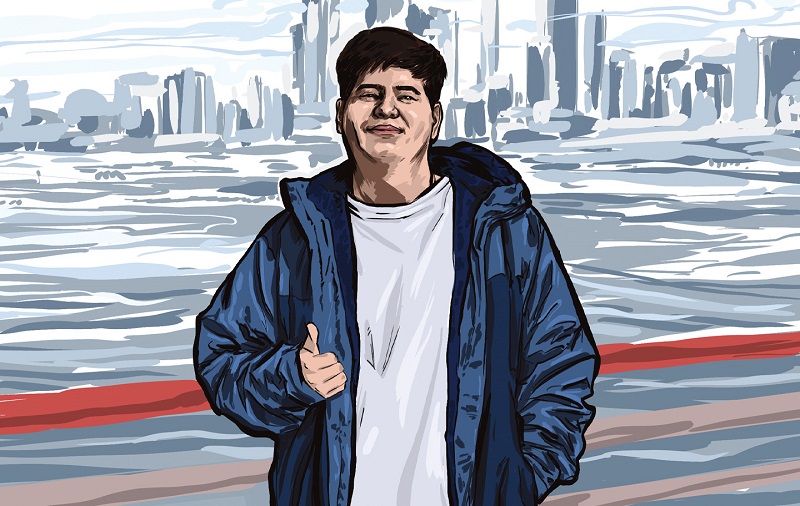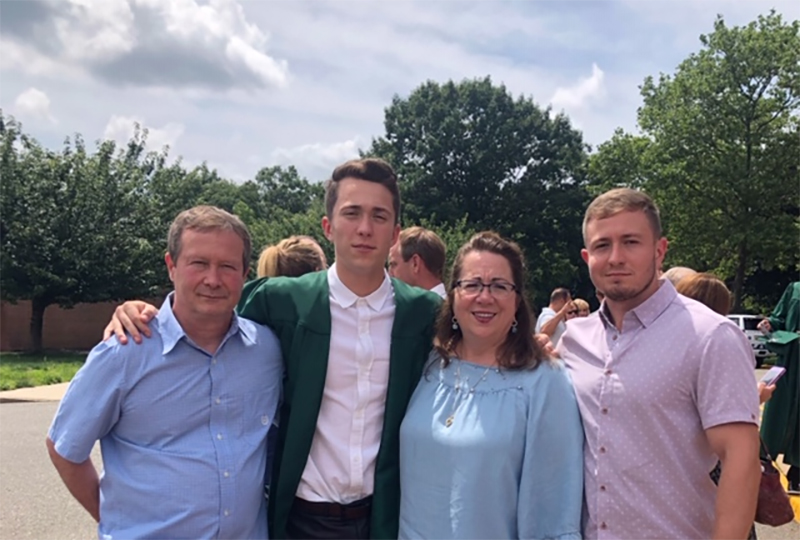22-year-old Makes Incredible Recovery from Both COVID-19 and Stroke

April 13, 2021
As a 22-year-old man, Danny Dominguez isn’t the typical stroke patient. The first time he experienced shortness of breath and headache accompanied by a throbbing sensation in April 2020, he went to a nearby hospital and was sent home with pain medication.
A few days later, he was at home and wasn’t feeling well. His intuition told him to give his mother a hug before she left for work. “It was just an instinct,” Danny says. “A few minutes later, I started losing consciousness and woke up in the hospital.”
Danny only remembers glimpses of the ensuing events, but he has since learned what happened from his family. His father and brother-in-law were at home with him when he collapsed, and they immediately called an ambulance. In the ambulance, Danny was unresponsive and admitted to the hospital—this time to Hackensack University Medical Center—as a stroke code.
In addition to the stroke, Danny had another complication: He was COVID-19-positive. “He was in a hypercoagulable state triggered by COVID-19,” says Ann Miller, M.D., neurologist at Hackensack, who, along with neurosurgeon Reza Karimi, M.D., initially treated Danny. This means the tendency of his blood to form clots was much higher than usual. “Imaging revealed that the clotting blocked blood flow in almost every vein in his venous system. Based on that imaging, Dr. Karimi and I had a big discussion in terms of how to manage him. I, quite frankly, wasn’t sure he was going to survive the night.”
She adds that we are still at the beginning of the learning curve, but research is being conducted to study the impact of COVID-19 on blood clotting.
Slow and Steady Progress
The first night Danny spent in the hospital, Drs. Miller and Karimi considered all of their options when discussing his treatment—from medication to blood vessel intervention to surgery. Fortunately, his body started to respond to the first medication treatment they provided, so they decided against taking a more aggressive plan of action.
“After that first night, it was little steps forward every day,” says Dr. Miller. “On the second day, he could answer simple yes-no questions, and by the third or fourth day, he was able to verbalize his thoughts. The first thing he asked was if he could speak to his mom, so we got her on the phone for him.”
Danny says it was scary to wake up at the hospital, but he was quickly comforted by a nurse who explained everything that had happened.
“I woke up wondering where I was, and the nurse came in and greeted me—she was very nice—and explained why I was in the hospital,” he recalls. “The whole left side of my body was numb: my left leg, my left arm, my face drooped, everything was numb and unresponsive. I could feel things, but I couldn’t move my body very much.”
The nurse told Danny he had a stroke, which surprised him. He acknowledged he wasn’t the healthiest 22-year-old, but he also didn’t have any major warning signs. He didn’t realize he was COVID-19-positive and the impact that had on his health.
Danny spent the next two weeks in the hospital, slowly relearning to walk and move his body. “They had me inch off the bed, with just my feet touching the ground, and they had to physically hold me to get me up into a stretcher or walker,” he says. “I would have this therapy almost every day for at least an hour, and it helped a lot.”
Danny was grateful for the attentive care he received from Dr. Miller and her team. “Even though I was worried, I was very comfortable with Dr. Miller,” he says. “I was stressed because I couldn’t talk to my family regularly, and Dr. Miller would always stop by and say ‘hi.’ She kept my mind off worrying.”
Danny made incremental progress each day, going from moving his hands and fingers to calf-strengthening exercises on the bed to walking through the hospital. “I was really proud of that,” he says. “Eventually, the droopy face disappeared, and I could talk normally again.”
Back on His Feet
At that point, Danny was transferred from Hackensack to a rehabilitation center. He spent two to three weeks in inpatient rehab, receiving physical therapy twice a day.
In addition to the physical effects, his mind was affected by the stroke. “I forgot everything that happened,” Danny says. “They had me doing brain and memory exercises to help me regain my memory.”
In the ensuing months, Danny continued outpatient therapy. Slowly but surely, he regained just about all of the functions he lost after the stroke. “When I began rehab, my goal was to be able to walk by myself,” Danny says. “Eventually, I got to that point and further. I feel so much better now. I can walk, exercise and jog.”
A soccer fan, Danny was happy to get back outside and kick the ball around with his cousins. While he hasn’t been able to do much of that due to the pandemic, knowing where he was after his stroke, it is a huge improvement.
Dr. Miller echoes Danny’s pride in his recovery. She credits the team at Hackensack for bringing Danny back to normalcy from the brink of death. “I’ve seen a number of patients with venous thrombosis, but none as severe as his,” says Dr. Miller. “I think it was due to the teamwork from everybody—the ICU staff, Dr. Karimi and his team, radiology and the physical therapy team—that Danny was able to get back to his normal life. It is gratifying to see the progress he made.”
Next Steps & Resources:
- Learn more about stroke care at Hackensack Meridian Health
- Meet our source: Ann Miller, M.D. To make an appointment with Dr. Miller or a doctor near you, call 800-822-8905 or visit our website.
The material provided through HealthU is intended to be used as general information only and should not replace the advice of your physician. Always consult your physician for individual care.
Find a doctor near me
Are Stroke Symptoms Different for Young People?

Learn about stroke symptoms in young adults from Dr. Miller. Understand risk factors & prevention strategies for a healthier life. Schedule an appointment today.
How to Help Prevent Stroke

Prevent stroke: Reduce your risk with expert tips from Dr. Uhrik. Learn how lifestyle changes can improve heart health. Call 800-822-8905.
Find a doctor near me

Overcoming COVID-19 and Cardiac Arrest: The Miracle Man
COVID-19, heart attack survivor Mark Renwanz shares his Ocean Medical Center recovery story. Learn how Drs. Okere and Delaluz helped him overcome the odds. Call 800-822-8905.

Stroke of Luck
Stroke recovery story: Gary Rumpf shares his experience at Raritan Bay Medical Center-Perth Amboy. Learn about stroke treatment and rehabilitation. Read his inspiring story.

When COVID-19 Strikes the Young
COVID-19: Young Adult's Experience. Learn about Tyler's severe illness and recovery at Bayshore Medical Center. Call 800-822-8905 for care.
Conquering Stroke
Conquering Stroke: Learn how Mountainside Medical Center's advanced stroke treatment helped Robert recover. Discover innovative care options.
